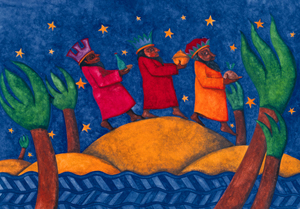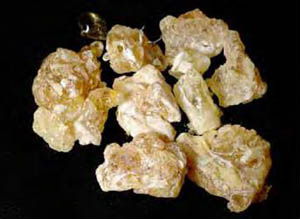 Were the gifts of the magi meant to save Jesus from the pain of arthritis? It’s possible, according to researchers at Cardiff University in Wales who have been studying the medical uses of frankincense.
Were the gifts of the magi meant to save Jesus from the pain of arthritis? It’s possible, according to researchers at Cardiff University in Wales who have been studying the medical uses of frankincense.
Since the early days of Christianity, Biblical scholars and theologians have offered varying interpretations of the meaning and significance of the gold, frankincense and myrrh that the magi presented to Jesus, according to the Gospel of Matthew (2:11). These valuable items were standard gifts to honor a king or deity in the ancient world: gold as a precious metal, frankincense as perfume or incense, and myrrh as anointing oil. In fact, these same three items were apparently among the gifts, recorded in ancient inscriptions, that King Seleucus II Callinicus offered to the god Apollo at the temple in Miletus in 243 B.C.E. The Book of Isaiah, when describing Jerusalem’s glorious restoration, tells of nations and kings who will come and “bring gold and frankincense and shall proclaim the praise of the Lord” (Isaiah 60:6). Although Matthew’s gospel does not include the names or number of the magi, many believe that the number of the gifts is what led to the tradition of the Three Wise Men.
Interested in learning about the birth of Jesus? Discover the history of Christmas and the date of Jesus’ birth in the free eBook The First Christmas: The Story of Jesus’ Birth in History and Tradition.

The traditional gifts of the magi—gold, frankincense and myrrh—may have had symbolic as well as practical value. Researchers believe the medicinal uses of frankincense were known to the author of Matthew’s gospel.
In addition to the honor and status implied by the value of the gifts of the magi, scholars think that these three were chosen for their special spiritual symbolism about Jesus himself—gold representing his kingship, frankincense a symbol of his priestly role, and myrrh a prefiguring of his death and embalming—an interpretation made popular in the well-known Christmas carol “We Three Kings.”
Still others have suggested that the gifts of the magi were a bit more practical—even medicinal in nature. Researchers at Cardiff University have demonstrated that frankincense has an active ingredient that can help relieve arthritis by inhibiting the inflammation that breaks down cartilage tissue and causes arthritis pain. The new study validates traditional uses of frankincense as an herbal remedy to treat arthritis in communities of North Africa and the Arabian Peninsula, where the trees that produce this aromatic resin grow. Did the magi “from the East” know of frankincense’s healing properties when they presented it to young Jesus?
This Bible History Daily feature was originally published in December 2011.
Related reading in Bible History Daily:
Did Jesus Exist? Searching for Evidence Beyond the Bible: Lawrence Mykytiuk’s full article from the January/February 2015 issue of BAR with voluminous endnotes
How December 25 Became Christmas: Andrew McGowan’s full article from the December 2002 issue of Bible Review
Witnessing the Divine: The magi in art and literature by Robin M. Jensen
Christmas Stories in Christian Apocrypha by Tony Burke
Bible Scholar Brent Landau Asks “Who Were the Magi”?
Who Was Jesus’ Biological Father?
Has the Childhood Home of Jesus Been Found?
Frankincense and Other Resins Were Used in Roman Burials Across Britain
Dig deeper into biblical Archaeology with your All-Access Membership
The world of the Bible is knowable. We can learn about the society where the ancient Israelites, and later Jesus and the Apostles, lived through the modern discoveries that provide us clues.
Biblical Archaeology Review is the guide on that fascinating journey. Here is your ticket to join us as we discover more and more about the biblical world and its people.
Each issue of Biblical Archaeology Review features lavishly illustrated and easy-to-understand articles such as:
• Fascinating finds from the Hebrew Bible and New Testament periods
• The latest scholarship by the world's greatest archaeologists and distinguished scholars
• Stunning color photographs, informative maps, and diagrams
• BAR's unique departments such as First Person and Strata
• Reviews of the latest books on biblical archaeology
The BAS Digital Library includes:
• 45+ years of Biblical Archaeology Review
• 20+ years of Bible Review online, providing critical interpretations of biblical texts
• 8 years of Archaeology Odyssey online, exploring the ancient roots of the Western world in a scholarly and entertaining way,
• The New Encyclopedia of Archaeological Excavations in the Holy Land
• Video lectures from world-renowned experts.
• Full online access to 50+ curated Special Collections,
• Four highly acclaimed books, published in conjunction with the Smithsonian Institution: Aspects of Monotheism, Feminist Approaches to the Bible, The Rise of Ancient Israel and The Search for Jesus.
The All-Access membership pass is the way to get to know the Bible through biblical archaeology.
The post Why Did the Magi Bring Gold, Frankincense and Myrrh? appeared first on Biblical Archaeology Society.


0 Commentaires